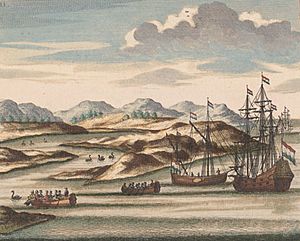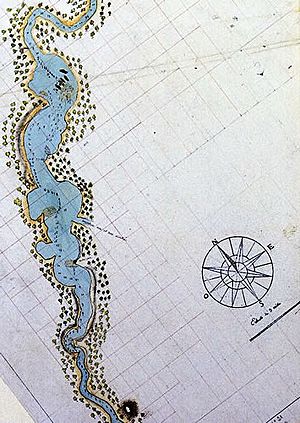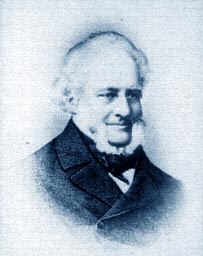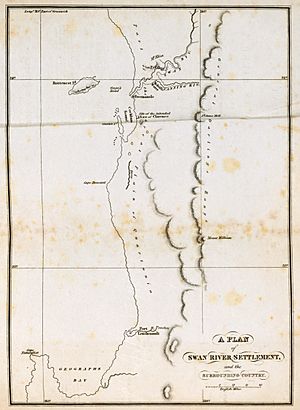Swan River Colony facts for kids
Quick facts for kids Swan River Colony |
|||||||
|---|---|---|---|---|---|---|---|
| 2 May 1829–6 February 1832 | |||||||
| History | |||||||
|
• Established
|
2 May 1829 | ||||||
|
• Disestablished
|
6 February 1832 | ||||||
|
|||||||
| Today part of | Australia | ||||||
The Swan River Colony, also known as the Swan River Settlement, was a British colony started in 1829. It was built on the Swan River in Western Australia. The main settlement area on the Swan River was soon named Perth. It became the capital city of Western Australia.
The name Swan River Colony was often used to mean all of Western Australia. On February 6, 1832, the colony was officially renamed the Colony of Western Australia. This happened when Captain James Stirling, the colony's first lieutenant-governor, finally received his official papers. Even after the name change, people still called it the Swan River Colony for many years.
Exploring the Area

The first Europeans to see the land where Perth is now were Dutch sailors. It's thought that Frederick de Houtman was the first to visit the Swan River area on July 19, 1619. He was on the ships Dordrecht and Amsterdam. His notes show he reached the Western Australian coast near Warnbro Sound. He didn't land because the waves were too big, so he sailed north.
On April 28, 1656, the ship Vergulde Draeck was on its way to Batavia (now Jakarta) when it was shipwrecked. This happened about 107 km north of the Swan River, near Ledge Point. Out of 193 people on board, only 75 made it to shore. A small boat from the wreck sailed to Batavia for help. But a search party later found none of the survivors. The wreck was found again in 1963.
In 1658, three ships from the Dutch Republic visited the area. They were partly looking for the Vergulde Draeck. The ships were Waekende Boey, Elburg, and Emeloort. They saw Rottnest Island but didn't go closer to the mainland because of many reefs. They then went north and found the wreck of Vergulde Draeck, but still no survivors. They thought the area was not good, partly because of the dangerous reefs.
The Dutch captain Willem de Vlamingh was the next European to visit. He had three ships: Geelvinck, Nijptangh, and Weseltje. He arrived at and named Rottnest Island on December 29, 1696. On January 10, 1697, he visited and named the Swan River. His ships couldn't sail up the river because of a sand bar at its entrance. So, he sent a small boat, which even then had to be dragged over the sand bar. They sailed until they reached muddy areas, probably near Heirisson Island. They saw some Aboriginal people but couldn't meet them closely. Vlamingh also didn't think the area was good for settlement. This is probably why the Dutch didn't explore it much after that.
In 1801, two French ships, Géographe (led by Nicolas Baudin) and Naturaliste (led by Emmanuel Hamelin), visited the area from the south. Géographe continued north, but Naturaliste stayed for a few weeks. A small group dragged longboats over the sand bar and explored the Swan River. They also said the area was not good for settlement. This was because of many muddy areas upstream and the sand bar. (The sand bar was not removed until the 1890s when C. Y. O'Connor built Fremantle harbour).
Later, in March 1803, Géographe, with another ship called Casuarina, passed by Rottnest. They were on their way back to France but only stopped for a day or two.
The next person to visit the area was Phillip Parker King in 1822 on the ship Bathurst. King was the first explorer born in Australia. He was also the son of former Governor Philip Gidley King of New South Wales. However, King was also not impressed with the area.
Why the Settlement Started
The person who helped start Western Australia was Captain James Stirling. In 1827, he explored the Swan River area in HMS Success. His ship first stopped near Rottnest and then in Cockburn Sound. He was with Charles Fraser, a botanist from New South Wales.
Their exploration began on March 8 with small boats. From March 13, parties continued on foot. In late March, Success went to Sydney, arriving on April 15. Stirling returned to England in July 1828. He spoke very highly of the area's farming potential. He pushed for a new type of settlement at the Swan River. This would be a free settlement, unlike the penal colonies (where prisoners were sent) in New South Wales, Port Arthur, and Norfolk Island. Stirling wanted to be its governor.
Because of his reports, and a rumor in London that the French might start a penal colony in western Australia, the British government agreed to the idea in October 1828.
In December 1828, the government decided to set aside land for the Crown (the government), for religious groups, and for education. They also said that land along the water would be limited. The British decided to start the Swan River settlement with very little exploration done. The plans for setting it up and giving out land were very basic. And only quick surveys were made before people actually moved onto their land.
Rules were made for giving land to settlers based on land grants. There were also talks about a private group running the settlement. This group was led by Potter McQueen, a member of Parliament. But the group pulled out when the government wouldn't give them special treatment over other settlers. However, one member, Thomas Peel, agreed to the terms and went ahead alone. Peel was promised 500,000 acres (200,000 ha) if he arrived at the settlement before November 1, 1829, with 400 settlers. Peel arrived after this date with only 300 settlers, but he still received 250,000 acres (100,000 ha).
Starting the Settlement
| Swan River Colony ship arrivals in 1829 |
|
|---|---|
| 25 April | HMS Challenger (Fremantle) |
| 31 May | Parmelia (Stirling) |
| 6 June | HMS Sulphur |
| 5 August | Calista |
| 6 August | Saint Leonard |
| 23 August | Marquis of Anglesea |
| 19 September | Thompson |
| 21 September | Amity |
| 5 October | Georgiana |
| 9 October | Ephemina |
| 12 October | Orelia |
| 12 October | Cumberland |
| 12 October | Caroline |
| 17 October | Governor Phillip |
| 19 October | Atwick |
| 23 October | Lotus John Summerson |
| 31 October | Admiral Gifford |
| 11 November | Lion (Lyon) |
| 14 November | Dragon |
| 28 November | HMS Success |
| 15 December | Gilmore (Peel) |
The first ship to reach the Swan River was HMS Challenger. It anchored near Garden Island on April 25, 1829, and then in Cockburn Sound on April 27. Captain Charles Fremantle officially claimed the Swan River Colony for Britain on May 2.
The ship Parmelia arrived in Cockburn Sound on June 2, carrying Stirling and his group. HMS Sulphur arrived on June 8, bringing members of the 63rd Regiment and their families. Three more merchant ships arrived soon after: Calista on August 5, St Leonard on August 6, and Marquis of Anglesea on August 23.
A series of problems happened after the ships arrived, which almost caused the whole plan to be given up. Challenger and Sulphur both hit rocks when entering Cockburn Sound. Luckily, they only had small damage. However, Parmelia, guided by Stirling, also ran aground. It lost its rudder and damaged its bottom, needing a lot of repairs. With winter starting, the settlers had to land on Garden Island. Bad weather and the repairs meant that Stirling didn't reach the mainland until June 18. The rest of the settlers from Parmelia finally arrived in early August. In early September, a big problem happened: Marquis of Anglesea was pushed ashore during a strong storm and was too damaged to be fixed. The ship didn't break apart as expected. Instead, it became Western Australia's first prison hulk (a ship used as a floating prison).
The first reports about the new colony reached England in late January 1830. They described the bad conditions and how the colonists were starving. They said the land was completely unsuitable for farming. They also incorrectly reported that the settlers had left the colony. Because of these reports, many people canceled their plans to move there. Some went to Cape Town in South Africa instead, or to the older, more settled New South Wales colony.
Despite this, some settlers still arrived, and more supplies were sent. By 1832, the colony's population reached about 1,500 people. Aboriginal people were not counted at that time. But it's thought there were about 15,000 in the southwest. Clearing land to grow crops was very difficult. So, by 1850, the settler population had only grown to 5,886. These people had mostly settled along the southwestern coast in places like Bunbury, Augusta, and Albany.
See also
 In Spanish: Colonia del Río Swan para niños
In Spanish: Colonia del Río Swan para niños




